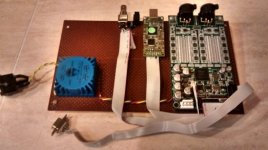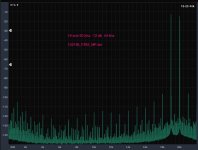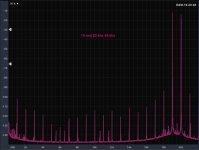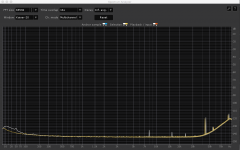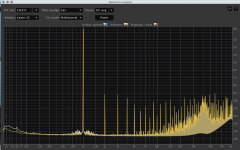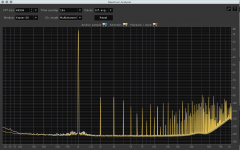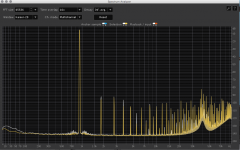Not sure why? I was a beginner when I started this thread. The content of this thread documents a learning curve as members try to nut out what works and what doesn't. You would have been better off asking questions here.
Right, I'll take you up on that!! Could you and others with knowledge of digital filters post a list of suggested reading for beginners wishing to delve into it and perhaps try their hand at building the filters?
Assume we are... Absolute Beginners. A Basic 101 to get us up to speed. And eventually maybe even a how-to.....
Right, I'll take you up on that!! Could you and others with knowledge of digital filters post a list of suggested reading for beginners wishing to delve into it and perhaps try their hand at building the filters?
Assume we are... Absolute Beginners. A Basic 101 to get us up to speed. And eventually maybe even a how-to.....
Start with:
Michael Gerzon: Why do equalisers sound different?
A4: http://www.audiosignal.co.uk/Resources/Why_do_equalisers_sound_different_A4.pdf
USL: http://www.audiosignal.co.uk/Resources/Why_do_equalisers_sound_different_USL.pdf
If you have never heard of Gerzon I'd suggest reading his obituary from Gramaphone
Gramophone Obituary
or from the Guardian
Ambisonic Surround Sound FAQ, version 2.8: Section 26
Then take a look at Julian Dunn's
"Anti-alias and anti-image filtering: The benefits of 96kHz sampling rate formats for those who cannot hear above 20kHz."
http://www.nanophon.com/audio/antialia.pdf
Goes through the issues with 44.1kHz filters to underscore the advantages of higher sampling rates.
Last edited:
Additionally I guess all the information that hifiduino has gathered in his blog regarding the filters, could also be useful for this thread. Maybe you could ask permission from him to also use it here, in the first page of this thread. https://hifiduino.wordpress.com/2015/01/30/building-soekris-r-2r-dac/
Please...
Start with:
Michael Gerzon: Why do equalisers sound different?.....
Thanks, Paul. Appreciated. And yes, I knew of Michael Gerzon but hadn't seen that tribute.
I measured the following filters.Does the altered FIR2 solve this?
1021filt_FIR2_MP.skr
A_CRaP_take_on_BH.skr
CRaPMagic_LP.skr
totalCRaP_rev2.skr
New FIR2 unfortunately is similar to Soekris FIR2. It was not like I thought FIR2 problem.
I think it's Jitter problem when the clock works at 44.1 and multiples. Could be clock speed periodically switching? With a larger buffer I could check if it is the problem. Soekris says can´t change the length of the buffer. So I can not verify if that is the problem.
But I have found that DAM1021 measures are better than other R2R DAC in to market with high prices.
So measures are not a problem. Only more improved on 48,... Now I looking for no clipping at 0 db. and a good phase and good impulse response.
I think it's Jitter problem when the clock works at 44.1 and multiples. Could be clock speed periodically switching? With a larger buffer I could check if it is the problem. Soekris says can´t change the length of the buffer. So I can not verify if that is the problem.
Please post a couple of J-test graphs with 44.1 and 48k signals (stock filter) where the 44.1k problem is clearly visible, so we can ask Søren to investigate the issue.
Thanks.
Messing around with rePhase. Please read the following with questionmark.
Copied pos’s filter from post #1630 and generated 32 bits float mono (txt).
Added a simple PEQ -3dB constant Q8 5100Hz and generated a new file.
Compared both files in ConTEXT editor. Not one single coefficients tap where identical. As expected as 1015 taps have to be distributed to more tasks.
By the look of it we do loose accuracy with 1015 taps when giving pos’s filter more to do.
Adding taps doesn’t always give result as predicted for beginners like me. Picture below show pos’s filter with the PEQ adjustment as before at 1033 and 1034 taps. It’s like rePhrase makes two different priorities for these two outputs? With my very limited knowledge I would in this case go for the one with less taps?
Changing windowing from ‘hann’ to ‘blackman-harris’ with my PEQ version did have impact on ringing. Anyone know if there exists a simple prons&cons list for rePhrase’s availably windowing styles?
Copied pos’s filter from post #1630 and generated 32 bits float mono (txt).
Added a simple PEQ -3dB constant Q8 5100Hz and generated a new file.
Compared both files in ConTEXT editor. Not one single coefficients tap where identical. As expected as 1015 taps have to be distributed to more tasks.
By the look of it we do loose accuracy with 1015 taps when giving pos’s filter more to do.
An externally hosted image should be here but it was not working when we last tested it.
Adding taps doesn’t always give result as predicted for beginners like me. Picture below show pos’s filter with the PEQ adjustment as before at 1033 and 1034 taps. It’s like rePhrase makes two different priorities for these two outputs? With my very limited knowledge I would in this case go for the one with less taps?
An externally hosted image should be here but it was not working when we last tested it.
Changing windowing from ‘hann’ to ‘blackman-harris’ with my PEQ version did have impact on ringing. Anyone know if there exists a simple prons&cons list for rePhrase’s availably windowing styles?
An externally hosted image should be here but it was not working when we last tested it.
Please post a couple of J-test graphs with 44.1 and 48k signals (stock filter) where the 44.1k problem is clearly visible, so we can ask Søren to investigate the issue.
Thanks.
It's not clock/pll jitter. The spread is far too wide around FS. Jitter would be close in, this is +/-4kHz so something else is happening here, possibly with FPGA clock division.
Anyway lets not get too distracted from the topic which is filters. If you want to follow on this low level system noise up the vendor thread is the place.
Hello B&W_arthur.
In my opinion is nonsense modded DAM1021 psu. It was the first thing I measured. I was thinking to improve it.
The psu is perfect with a 7v. transformer. The DAM1021 is very good power supply. And you will not get any improvement in this case with modded psu.
I have measured two DAM1021, is no defective board. ((Or I have two equally bad board).
The waves test has made in Audacity and stored in 24 bit.
I check in Audacity that the wav 24 bit signal has distortion below -170 dB. MAC mini and Pure Music software reproduce Wav test to USB Amanero or to Hiface SPDIF. Also I have Amarra and Audirvana. The PureMusic is getting less jitter and harmonic distortion signal measures.
I measured with Mac Book Pro, Motu Ultralite MKIII card and Smaart software.
I have other DACs in which these problems do not appear this guarantee me that is no problem of measuring equipment. And I have another device Tektronix AM700 in which the measure is the same. I prefer using Smaart because it allows me to compare and save the measurements.
To correctly measure I must power on the DAC and Motu several hours before. Especially for measuring jitter.
After seeing these measures I am less concerned.
MSB Technology Platinum Data CD IV transport & Diamond DAC IV & D/A converter Measurements | Stereophile.com
The strange thing is that multiples of 48k. are very perfect. It is more important to put phase and impulse filters response measurements at the output. Is more interesting for quality sound.
In my opinion is nonsense modded DAM1021 psu. It was the first thing I measured. I was thinking to improve it.
The psu is perfect with a 7v. transformer. The DAM1021 is very good power supply. And you will not get any improvement in this case with modded psu.
I have measured two DAM1021, is no defective board. ((Or I have two equally bad board).
The waves test has made in Audacity and stored in 24 bit.
I check in Audacity that the wav 24 bit signal has distortion below -170 dB. MAC mini and Pure Music software reproduce Wav test to USB Amanero or to Hiface SPDIF. Also I have Amarra and Audirvana. The PureMusic is getting less jitter and harmonic distortion signal measures.
I measured with Mac Book Pro, Motu Ultralite MKIII card and Smaart software.
I have other DACs in which these problems do not appear this guarantee me that is no problem of measuring equipment. And I have another device Tektronix AM700 in which the measure is the same. I prefer using Smaart because it allows me to compare and save the measurements.
To correctly measure I must power on the DAC and Motu several hours before. Especially for measuring jitter.
After seeing these measures I am less concerned.
MSB Technology Platinum Data CD IV transport & Diamond DAC IV & D/A converter Measurements | Stereophile.com
The strange thing is that multiples of 48k. are very perfect. It is more important to put phase and impulse filters response measurements at the output. Is more interesting for quality sound.
Attachments
Compared both files in ConTEXT editor. Not one single coefficients tap where identical. As expected as 1015 taps have to be distributed to more tasks.
By the look of it we do loose accuracy with 1015 taps when giving pos’s filter more to do.
Why would you expect them to be the same? You have created two different filters so of course the co-efficents are different. Zoom in on the passband by setting the frequency range to 10kHz - 20kHz and amplitude to -0.5 and +0.5dB, then compare POS's filter with your PEQ enhanced version.
As noted rePhase has a problem with even taps. Adding taps is not a magic bullet, you might find decreasing taps works in some circumstances.Adding taps doesn’t always give result as predicted for beginners like me. Picture below show pos’s filter with the PEQ adjustment as before at 1033 and 1034 taps. It’s like rePhrase makes two different priorities for these two outputs? With my very limited knowledge I would in this case go for the one with less taps?
Changing windowing from ‘hann’ to ‘blackman-harris’ with my PEQ version did have impact on ringing. Anyone know if there exists a simple prons&cons list for rePhrase’s availably windowing styles?
It currently doesn't have kaiser windowing, although this is promised for the next release.
You'll need to read up on windowing as it's not a rePhase "pro and con" - you are simply dealing with the behaviour of specific types of windowing function.
Window function - Wikipedia, the free encyclopedia
Hann and Blackman-nuttal often work well but I found it was a matter of trial and error to see which window gave the best result for a specific curve and FFT length.
Keep in mind that rePhase applies FFT using the combination number of bins and windowing type to the curve you designed to generate the co-efficents. Increasing the number of FFT bins means finer frequency resolution in the conversion, but increases processing time and doesn't guarantee a better result.
The main downside for me is it runs on Winblows only. SoX/Octave/MATLAB are cross platform which makes that route accessible to Win/Lin/OSX users.
cheers
Paul
Last edited:
The strange thing is that multiples of 48k. are very perfect. It is more important to put phase and impulse filters response measurements at the output. Is more interesting for quality sound.
I've attached 3 screenshots of Isotope RX.
First is the DAM playing silence from an undithered 16/44.1kHz file.
Next 1kHz tone at 44.1kHz
Last 1 kHz tone at 48kKz
This is all done Macbook Pro -> USB -> Amanero -> TC Electronics Konnet 8 (with Welborne Labs Linear PSU) -> RX (on MbP).
The silence was at full volume - there is full scale test tone at the start that was clipping.
The SignalSuite tones were set at Master Volume 100%, Amplitude 80% which gives -0.5dB meter reading. If I go any higher the inputs start to clip.
The low level peaks on each side of the main tone are jitter artifacts imo and are at worst -136dB below the main tone. Also note the 50Hz mains tone at -134dB - this is with a directly hooked up 7VA trafo.
Attachments
I know what is going on!
1000hz is the same frequency, but they are different multiples of the sampling rate.
1000/44100 = 0.022667
1000/48000 = 0.020833
To test at 48k with the same test tone/sampling rate ratio you need to
(1000/44100)*48000 = 1088.4353741496hz
or alternatively
(1000/48000)*44100 = 918.749999999853hz (918.745hz is close enough)
Attached is results at 44.1kHz and test tone at 918.745hz. If you test at 48kHz 1088.43 the results look close to those for 1k/44.1khz.
So the difference is largely down to the different relationships between test tone and sampling rate.
1000hz is the same frequency, but they are different multiples of the sampling rate.
1000/44100 = 0.022667
1000/48000 = 0.020833
To test at 48k with the same test tone/sampling rate ratio you need to
(1000/44100)*48000 = 1088.4353741496hz
or alternatively
(1000/48000)*44100 = 918.749999999853hz (918.745hz is close enough)
Attached is results at 44.1kHz and test tone at 918.745hz. If you test at 48kHz 1088.43 the results look close to those for 1k/44.1khz.
So the difference is largely down to the different relationships between test tone and sampling rate.
Attachments
I know what is going on!
Excellent insight.
Have you thought of making a filter for old people? We can't hear past 16K. This gives you 4K more of transition band
Excellent insight.
Have you thought of making a filter for old people? We can't hear past 16K. This gives you 4K more of transition band
Are you checking to see who is reading your blog?
I agree that the tone/sampling rate ratio (e.g. the number of samples of one period of the tone is one important thing to conserve.
Why? I think because of that:
The graphs look to a great part like what you see as the aliases of the harmonics in the textbooks (you get harmonics if your periodic signal is not perfectly sine, whatever in your chain may be responsible for that).
These harmonics are mapped modulo fs in the 0-fs/2 range.
As (n-abs(i*f mod(2n) -n), n=fs/2, to be precise. So you "see" more harmonics the smaller the greatest common divisor of v and fs is.
The fewest harmonics aliases you see if tone/sampling rate ratio an small integer.
That is why 1kHz with fs=48kHz looks " cleaner than (only maximal 24 aliases)
than 1kHz with fs=44.1kHz (tons of aliases).
Of cause usually the higher harmonics get week and so may not play a role.
Why? I think because of that:
The graphs look to a great part like what you see as the aliases of the harmonics in the textbooks (you get harmonics if your periodic signal is not perfectly sine, whatever in your chain may be responsible for that).
These harmonics are mapped modulo fs in the 0-fs/2 range.
As (n-abs(i*f mod(2n) -n), n=fs/2, to be precise. So you "see" more harmonics the smaller the greatest common divisor of v and fs is.
The fewest harmonics aliases you see if tone/sampling rate ratio an small integer.
That is why 1kHz with fs=48kHz looks " cleaner than (only maximal 24 aliases)
than 1kHz with fs=44.1kHz (tons of aliases).
Of cause usually the higher harmonics get week and so may not play a role.
- Home
- Source & Line
- Digital Line Level
- Filter brewing for the Soekris R2R
